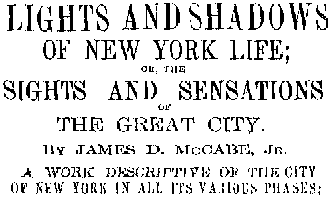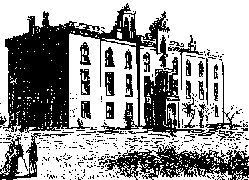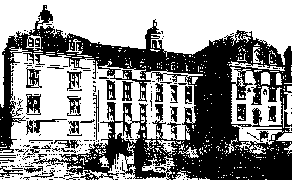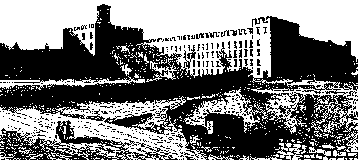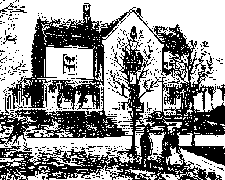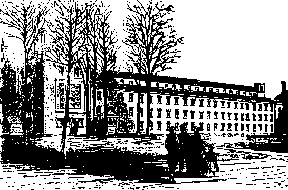|
Before Rikers, Blackwell's Was DOC's Island HomePart 3 of 3Excerpts from a book published in 1872:The three islands lying in the East River are among the most noticeable features of New York, and offer many attractions to the visitor to the city. They are Blackwell's, Ward's, and Randall's islands. Of these, Blackwell's Island is the most southern. It is almost a mile and three-quarters in length, extending from Fifty-first to Eighty-eighth street, and comprises an area of about 120 acres. It takes its name from the Blackwell family, who once owned it, and whose ancestral residence, a tasteful wooden cottage, over a hundred years old, stands near the centre of the island, and is occupied by the Keeper of the Almshouse.The island was purchased by the city in 1828, for the sum of $30,000. A further outlay of $20,000 was made in 1843 to perfect the title. The land alone is now worth over $600,000. The island is surrounded by a granite sea-wall, and has been made to slope gradually towards the water of each side by a thorough system of grading. This labor was performed by the convicts of the Penitentiary, and the inmates of the Workhouse. There is an excellent dock near the Penitentiary for boats, but no vessels were allowed to land here but the boats of the Department of Charities and Corrections. Visitors must obtain a permit from this department or they will not be allowed to set foot upon the island. The institutions on this and the other islands are supplied with Croton water, a large main being carried across under the river.
Those who are able to pay are required to do so. At the water's edge, on the eastern side of this hospital, are several wooden buildings designed for the treatment
of patients suffering from typhus and ship fever. These will
accommodate one hundred patients, though the number is often
greater.
Immediately in the rear of the Small-pox Hospital, though far
enough from it to be removed from danger, is the Charity Hospital,
a magnificent structure of gray granite, said to be the largest
hospital in America. It consists of a central building with
two wings, each three and a half stories in height, with a Mansard
roof. The entire building is 35 feet long, and 122 feet
wide. The eastern wing is occupied by males, and the western
by females. The hospital is divided into 29 wards, the
smallest of which contains 13 beds, and the largest 39.
Twelve hundred patients can be accommodated with comfort. . . .
About seven thousand patients are annually treated here, the
majority being charity patients. The average number of
deaths is about four hundred and fifty. The prisoners at this institution are sent here by the city courts,
for terms of from one to six months. Some, however, are
sentenced to imprisonment for several years. The convicts
are all required to labor. Formerly the men were required to
engage in excavating stone from the rich quarries with which the
island abounded, but which have now been exhausted. The
erection of the new buildings in Randall's, Ward's, and Hart
Islands, furnishes constant employment to the convicts, who are
daily conveyed between the prison and these institutions.
Those who are able to work at the ordinary trades are allowed to do
so in the workshops of the Penitentiary. The women are
required to do sewing, housework, and the like. No visitors are allowed on the Penitentiary grounds without a permit from the Commissioners. Sentinels are stationed along the water fronts, and the guard-boats patrol the river to prevent the escape of convicts. In spite of these precautions, however, men have succeeded in making their escape to the opposite shore.
The convicts are clothed in a uniform of striped woolen garments,
and are supplied with a sufficient amount of bedding and with an
abundance of excellent but plain food. The allowance is
about one pound of beef, and a quart of vegetable soup at dinner,
ten ounces of bread at each meal, and one quart of coffee at
breakfast and supper, to each man. In 1869, the total number
of prisoners confined here during the year was 2005. A very
large number of those sentenced to the Penitentiary are under the
age of twenty-five. The proportion of females is about
one-fifth. The foreigners are a little more than one-half of
the whole number. A system of evening schools, at which the
attendance is voluntary, has been initiated. The commutation
system is also practiced, by which the prisoner by good conduct may
receive a proportionate abridgment of his term of
confinement. Such conduct is reported every month by the
Warden to the Commissioners. who report it to the Governor of
the State, who alone has the power to shorten the terms in the
manner mentioned. Religious services are conducted every
Sabbath by Protestants and Roman Catholic clergymen. To the north of the Penitentiary are two handsome and similar structures of stone, separated by a distance of 650 feet. These are the Almshouses. Each consists of a central story, fifty feet square and fifty-seven feet high, with a cupola thirty feet in height, and two wings, each ninety feet long, sixty feet wide, and forth feet high. Each is three stories in height. Each floor is provided with an outside iron verandah, with stairways of iron, and each building will furnish comfortable quarters for 600 people, adults only admitted. One of these buildings is devoted exclusively to men, the other to women. . . . None but the aged and infirm, who are destitute, are admitted. Each new-comer is bathed immediately upon his or her arrival, and clad in the plain but comfortable garments provided by the establishment. He is then taken to the Warden's office, where his name, age, and bodily condition are registered. . . . In the female house, the infirm are more numerous than among the males. Those able to work are employed in sewing and knitting, in keeping the wards in order, and in nursing the feeble and cripples. In 1870, there were 1114 persons in the Almshouses, from fifteen years of age upwards, a special provision is made in each house for blind inmates. Attached to the Almshouse are the Hospitals for Incurables, which consists of two one-story buildings, 175 feet long, and 25 feet wide. One is devoted to men and the other to women. In these buildings are quartered those who are afflicted with incurable diseases, but who require no medical attention.
The Bureau for the Relief of the Outdoor Poor is connected with the Almshouse, though it conducts its operations in the city. The city is divided into eleven districts, each of which is in charge of a visitor, subject to the orders of the Superintendent of the Bureau. It is the duty of these visitors to examine into the causes of sickness, crime, and pauperism in their respective districts, and to report their observations to the Superintendent, who communicates them to the Department of Charities and Corrections. Temporary shelters given to needy persons in the winter, and money, fuel, food, clothing, etc., distributed to deserving persons. In 1869, 5275 families were given money, and 7555 fuel by this Bureau; $128,000 being expended for these charities.
In the rear of the Almshouse is the Workhouse, one of the handsomest buildings on the island. It is constructed of hewn stone, and consists of a central building four stories in height, with a northern and a southern wing, with a traverse section across the extreme end of each wing. In these traverse sections are located the workshops. The entire length of the building is 680 feet. Not counting the convict labor, the cost of its construction was over $100,000. The stone of which it was built was obtained on the island. In the central building are located the kitchens and store-rooms, the private quarters of the Superintendent and the other officials, and a large and handsome chapel. The wings contain each a broad hall, on each side of which are three tiers of cells, one above the other. Iron galleries, with stairways, extend along the fronts of these cells, and afford access to them. There are 150 cells in each wing. Each cell is provided with an iron grated door, and contains four single berths. The cells are separated from each other by brick walls. In the workshops, the carpenter's, blacksmith's, wheelwright's, tinner's, tailor's, and other trades are carried on. The men are also kept at work grading the island, building the seawall, and cultivating the gardens. Gangs of laborers are sent daily to engage in the works on Ward's and Randall's islands. The women are made to do the housework and cleaning of the various institutions on the island, and are employed in washing, mending, sewing, knitting, etc. All the inmates are obliged to labor. The number of persons annually sent to the Workhouse is from 15,000
to 20,000. The vagrant, dissipated, and disorderly classes
are sent here by the city police courts, ten days being the average
term of commitment. Drunkenness is the principal cause of
their detention here. Very few are Americans. Of the
foreigners, the Irish are the most numerous, the Germans are
next. Back of the Workhouse, and occupying the extreme upper portion of the island, is the New York Lunatic Asylum. It is a large and commodious building, with several out-buildings, with accommodations for 576 patients. A new Lunatic Asylum is now in course of erection on Ward's Island. It is to accommodate 500 patients. It is one of the most complete establishments in the country, and is built of brick and Ohio freestone. It is a very handsome building, with an imposing front of 175 feet. The two asylums will accommodate 1076 patients, but they are not adequate to the accommodation of all the afflicted for whom the city is required is to provide. Still further accommodations are needed. In 1870, the number of patients committed to the care of the Commissioners were over 1300.
The above excerpts are from |
